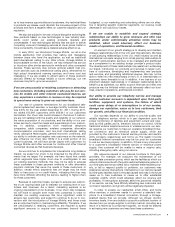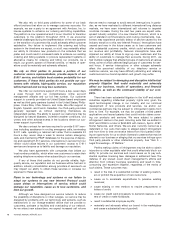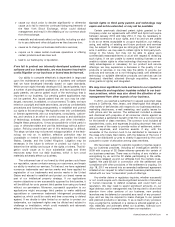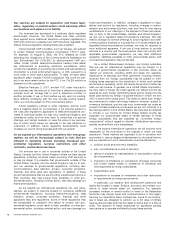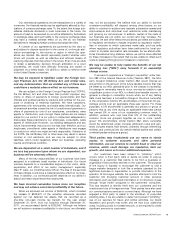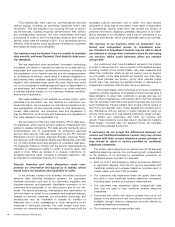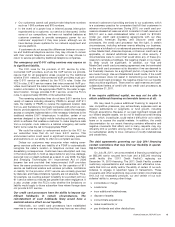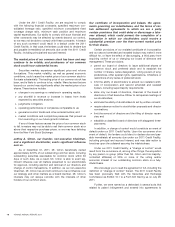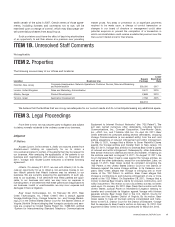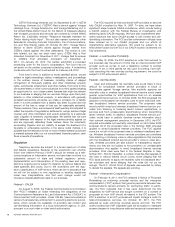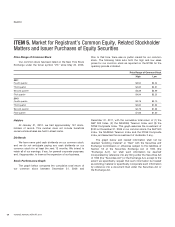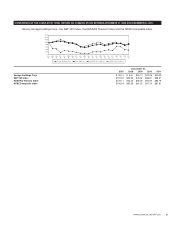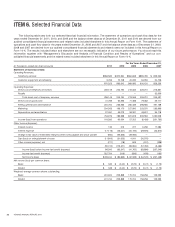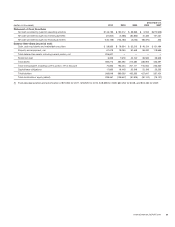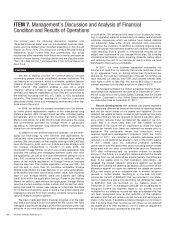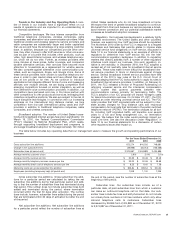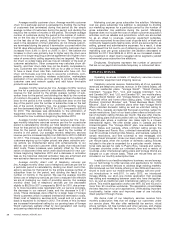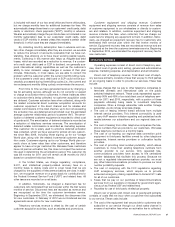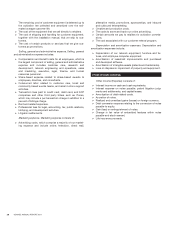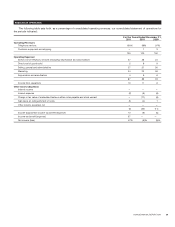Vonage 2011 Annual Report Download - page 27
Download and view the complete annual report
Please find page 27 of the 2011 Vonage annual report below. You can navigate through the pages in the report by either clicking on the pages listed below, or by using the keyword search tool below to find specific information within the annual report.
for local calls that terminate to the public switched telephone
network (“PSTN”). It also subjected PSTN originated traffic
directed to VoIP subscribers to similar ICC obligations. The
termination charges for all traffic, including VoIP originated traf-
fic, will transition over several years to a bill and keep arrange-
ment (i.e., no termination charges). We believe that the order
would positively impact our costs over time. Numerous parties
filed appeals of the FCC order in multiple federal circuit courts of
appeal. The 10th Circuit Court of Appeals was selected by lot-
tery to decide the appeals. The appeals are pending.
State Telecommunications Regulation
In general, the focus of interconnected VoIP tele-
communications regulation is at the federal level. On
November 12, 2004, the FCC issued a declaratory ruling provid-
ing that our service is subject to federal regulation and pre-
empted the Minnesota Public Utilities Commission from
imposing certain of its regulations on us. The FCC’s decision
was based on its conclusion that our service is interstate in
nature and cannot be separated into interstate and intrastate
components. On March 21, 2007, the United States Court of
Appeals for the 8th Circuit affirmed the FCC’s declaratory ruling
preempting state regulation of our service. The 8th Circuit found
that it is impossible for us to separate our interstate traffic from
our intrastate traffic because of the nomadic nature of the serv-
ice. As a result, the 8th Circuit held that it was reasonable for the
FCC to preempt state regulation of our service. The 8th Circuit
was clear, however, that the preemptive effect of the FCC’s
declaratory ruling may be reexamined if technological advances
allow for the separation of interstate and intrastate components
of the nomadic VoIP service. Therefore, the preemption of state
authority over our service under this ruling generally hinges on
the inability to separate the interstate and intrastate components
of the service.
While this ruling does not exempt us from all state oversight
of our service, it effectively prevents state telecommunications
regulators from imposing certain burdensome and inconsistent
market entry requirements and certain other state utility rules
and regulations on our service. State regulators continue to
probe the limits of federal preemption in their attempts to apply
state telecommunications regulation to interconnected VoIP
service. On July 16, 2009, the Nebraska Public Service
Commission and the Kansas Corporation Commission filed a
petition with the FCC seeking a declaratory ruling or, alter-
natively, adoption of a rule declaring that state authorities may
apply universal service funding requirements to nomadic VoIP
providers. We participated in the FCC proceedings on the peti-
tion. On November 5, 2010, the FCC issued a declaratory ruling
that allowed states to assess state USF on nomadic VoIP pro-
viders on a going forward basis provided that the states comply
with certain conditions to ensure that imposing state USF does
not conflict with federal law or policy. We expect that state pub-
lic utility commissions and state legislators will continue their
attempts to apply state telecommunications regulations to
nomadic VoIP service.
State and Municipal Taxes
In accordance with generally accepted accounting princi-
ples, we make a provision for a liability for taxes when it is both
probable that a liability has been incurred and the amount of the
liability or range of liability can be reasonably estimated. These
provisions are reviewed at least quarterly and adjusted to reflect
the impacts of negotiations, settlements, rulings, advice of legal
counsel, and other information and events pertaining to a
particular case. For a period of time, we did not collect or remit
state or municipal taxes (such as sales, excise, utility, use, and
ad valorem taxes), fees or surcharges (“Taxes”) on the charges
to our customers for our services, except that we historically
complied with the New Jersey sales tax. We have received
inquiries or demands from a number of state and municipal tax-
ing and 911 agencies seeking payment of Taxes that are applied
to or collected from customers of providers of traditional public
switched telephone network services. Although we have con-
sistently maintained that these Taxes do not apply to our service
for a variety of reasons depending on the statute or rule that
establishes such obligations, a number of states have changed
their statutes to expressly include VoIP and we are now collect-
ing and remitting sales taxes in those states. In addition, many
states address how VoIP providers should contribute to support
public safety agencies, and in those states we remit fees to the
appropriate state agencies. We could also be contacted by state
or municipal taxing and 911 agencies regarding Taxes that do
explicitly apply to VoIP and these agencies could seek retro-
active payment of Taxes. As such, we have a reserve of $2,231
as of December 31, 2011 as our best estimate of the potential
tax exposure for any retroactive assessment. We believe the
maximum estimated exposure for retroactive assessments is
approximately $5,000 as of December 31, 2011.
ITEM 4. Mine Safety Disclosures
Not Applicable.
VONAGE ANNUAL REPORT 2011 19


